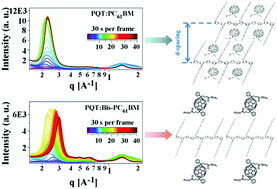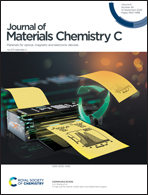Bimolecular crystal instability and morphology of bulk heterojunction blends in organic and perovskite solar cells†
Abstract
The performance of polymer:fullerene bulk heterojunction (BHJ) solar cells is significantly influenced by the morphology of electron donor and acceptor blends under the premise that electronic structure is complimentary regarding donor and acceptor materials. There are many cases where intimate mixing of donor and acceptor perturbs the electronic structure, which fundamentally changes the transport and photovoltaic characteristics. Here, we present the bimolecular crystal packing of polymers and fullerenes, and investigate the correlation between device performance and structural details. We find that bimolecular crystallization can reorganize polymer chain packing, leading to poor electron transport and device performance. The size compatibility and the passivation of entropy penalty led to cocrystallization instability, which was clearly seen by in situ GIWAXS data. PC61BM is found to intercalate into side chains of PQT by reorganizing both PQT and PC61BM, forming stable, highly ordered bimolecular crystals. The poor electron transport in bimolecular crystal domain could account for the poor device performance in both perovskite and organic solar cells. Bis-PC61BM, on the other hand, only forms loosely packed aggregates in solution, and then rapidly phase separated into large domains with an edge-on interfacial orientation and performed poorly in solar cells.



 Please wait while we load your content...
Please wait while we load your content...
